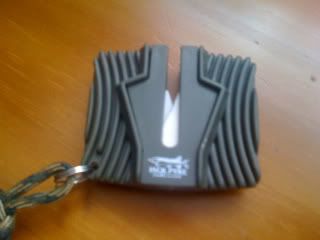... I've been using this type of pocket sharpener for years now ... have been warned against this type of sharpener for fear of 'wrecking' the edge rather than honing it...
That is very possible.
There are some good sharpening tips in several of the forum stickies and some articles too. They're worth spending a bit of quality time with if you're going to get serious about sharpening things. I'm semi-serious about it but there are people here who make me feel like a rank amateur.

A lot depends on how you use your blades, how you maintain them, how they differ, how fussy you are and in what way (for example I get no kicks at all out of shaving with my blades, others seem to live for it...), and the list goes on.
I personally don't like the crossover style and similar sharpeners much although I do have a couple and I use them occasionally on kitchen knives. I wouldn't use them on any of my tools. The angles and profiles on blades can be very important, and with the crossover style you usually get whatever you get, although some are adjustable. They don't offer much in terms of profiling, so if you want a microbevel or a convex edge for example you could find better ways of doing it. If the angles on the blade don't match the angles on the crossover sharpener and/or the profile of the blade section isn't all straight lines then you might have to take a
lot of metal off the blade before the sharpener acts in the way it's supposed to. You might tear chunks out of the blade during the process because until the sharpener puts its own profile on the blade section it makes very small contact patches on the blade and digs in. If some blades are stainless and other blades aren't you might contaminate the stainless with non-stainless particles by using the same sharpener for all your blades.
A stone is much more flexible and the Heinnie one looks handy although I've never seen one. Having said that, a stone can take a lot more metal off an edge than is really necessary. Especially with the more hard wearing steels that are coming along now I would recommend trying something less aggressive such as a steel (perhaps a ceramic one) or stropping. Unless you've done something horrendous with a blade you'll rarely need to do very much work on it to get it back in shape, it shouldn't need a lot of metal removed. The blade will last very much longer that way.
One way an edge can become blunt is by the edge rolling (bending) rater than wearing. A steel can rectify this without removing any metal at all, and to fix the problem with a stone is a terrible waste of metal and effort. A steel can provide valuable work hardening too. More modern, harder steels will tend to suffer less from this effect as will edges with a stronger profile such as convex edges, those with more obtuse angles and those with microbevels (which are just more obtuse but over a smaller part of the blade).
You haven't mentioned serrations but they're a different kettle of fish altogether, using a steel and stropping aren't really options unless you steel with a paper clip and strop with a leather bootlace which I would find tedious. I touch up the serrated edge on my Victorinox Super Tool very lightly every once in a while with an oval India file (similar to the Heinnie stone but simpler) and that's about it.
I think the DC3/DC4 are expensive for what they do but I bought one for my wife (well it came with her O1 bushy). I don't have a bushy style knife but I do occasionally borrow the stone for carbon steel tools.

Again the diamond side is a little aggressive for my liking but the ceramic side is lovely.
All in all I'd say try to get the feel of sharpening what I would call 'freehand'. It's a lot more flexible, you can make the edge suit the task better and it's likely to make the tools last a lot longer. I find that very satisfying as they can be pricey.



